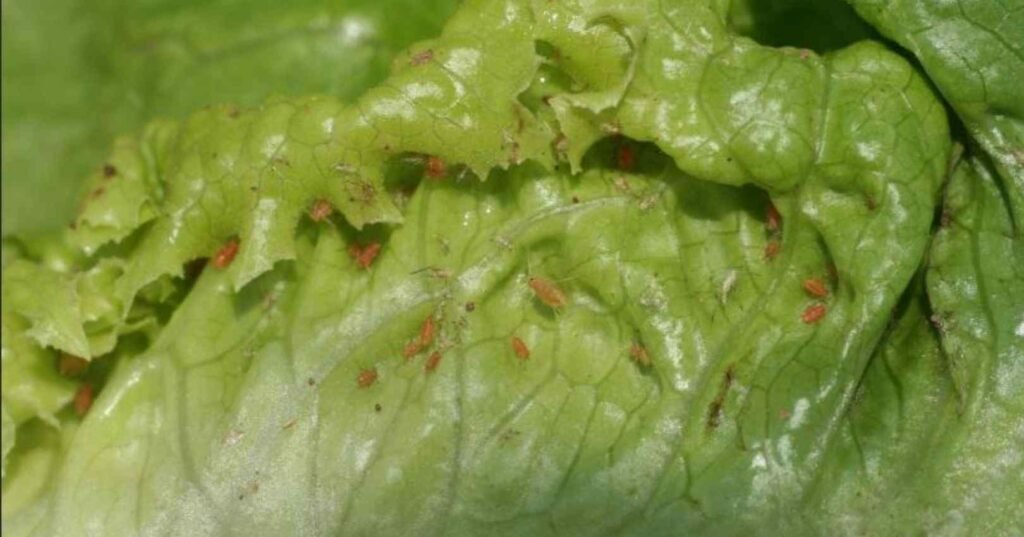You’re about to whip up a fresh salad when you notice some unwelcome guests on your store-bought lettuce. Yikes! But don’t panic just yet.
If you find bugs on your lettuce from the store, remove any visible insects and damaged leaves, then soak the lettuce in cold water with vinegar or salt. Rinse it thoroughly under running water, dry it, and store it in the fridge. Most bugs are harmless if accidentally consumed, but thorough cleaning is essential.
So, what’s the deal with these creepy-crawlies, and how can you prevent them from hitching a ride on your greens in the future? I’ve got the scoop on everything you need to know!
Is It Okay To Eat Lettuce That Had Bugs On It?

Encountering bugs on store-bought lettuce is not unusual. Generally, these insects are harmless if accidentally ingested.
However, their presence can indicate contamination or that the lettuce is starting to decay, which may affect the quality of your greens.
Safe Eating Practices
- Washing: Always wash lettuce thoroughly in cold water to remove dirt, bacteria, and potential insects. This doesn’t guarantee eradication of all contaminants, but it significantly reduces the risk.
- Inspecting: Look closely at the leaves for any remaining bugs or eggs. It’s a good idea to discard the outermost leaves as they have the most exposure to bugs and environmental contaminants.
Health Considerations
- Stomach Upset: For some people, consuming small insects with lettuce can lead to minor stomach discomfort, although this is relatively rare.
- Pesticides: More concerning might be any pesticides the bugs have been in contact with. If bugs are numerous, it could suggest heavy pesticide use, which you might inadvertently ingest.
Prevention Tips
- Storage: Store lettuce properly in the refrigerator to deter bug infestation.
- Separation: Keep lettuce separate from fruits that emit ethylene gas, like apples and bananas, which can accelerate decay and attract more bugs.
Insects on lettuce are typically more of a nuisance than a health hazard. Taking proper steps to clean and inspect your lettuce should make it perfectly safe to eat.
You might also consider purchasing organic lettuce, which can have fewer pesticide-related concerns, although it’s not immune to bug visits.
Types Of Bugs Found On Store-Bought Lettuce

When you bring home a fresh head of lettuce from the store, you might sometimes find uninvited guests nestled between the leaves. Let’s take a closer look at the types of bugs that often accompany your leafy greens.
- Aphids: These tiny, soft-bodied insects tend to cluster on the undersides of leaves. Although they’re small, aphids can multiply quickly and may be green, brown, or black. You can remove them by rinsing the leaves in cold water or using a mild soap solution.
- Thrips: Thrips are slender, winged insects that leave silvery or brown streaks on lettuce leaves. They’re a bit trickier to spot due to their size and color.
- Caterpillars and Larvae: You might find these munching on your greens, leaving visible holes behind. They are often the larvae of moths or butterflies.
- Slugs and Snails: More common if the lettuce is from an outdoor source, slugs and snails might be found on the lettuce and can be handpicked off.
| Insect Type | Appearance | Removal Method |
|---|---|---|
| Aphids | Small, soft-bodied | Rinse or mild soap solution |
| Thrips | Slender, winged | Rinse with water |
| Caterpillars and Larvae | Various sizes, worm-like | Handpick and rinse |
| Slugs and Snails | Soft, slimy, typically without shell | Handpick |
Remember to inspect your lettuce carefully, wash the leaves thoroughly, and if necessary, use natural remedies to ensure these insects don’t end up as unintended salad ingredients.
Washing the lettuce also helps in removing potential pesticides and dirt, making it safe and delicious to consume.
How to Clean and Prepare Lettuce with Bugs
If lettuce has been exposed to bugs, it is necessary to clean it meticulously. Begin by rinsing the leaves under running water, making sure to separate them so all areas are reached. Any remaining dirt or bugs can be removed by gently rubbing the leaves with your fingers.
For an extra level of cleanliness, you could consider soaking the lettuce in a mixture of water and a dash of vinegar (3:1 ratio is suitable) for a few minutes.
This can help get rid of any lingering bugs or bacteria. After soaking, it’s important to rinse the lettuce well under cold water to get rid of any vinegar taste.
Here’s a simple breakdown of the process:
| Step | Action | Purpose |
|---|---|---|
| 1. Wash | Rinse under running water, separate leaves. | Removes visible dirt and bugs. |
| 2. Soak | Immerse in water-vinegar solution. | Helps remove hidden pests. |
| 3. Rinse | Rinse thoroughly under cold water. | Removes vinegar taste, final clean. |



